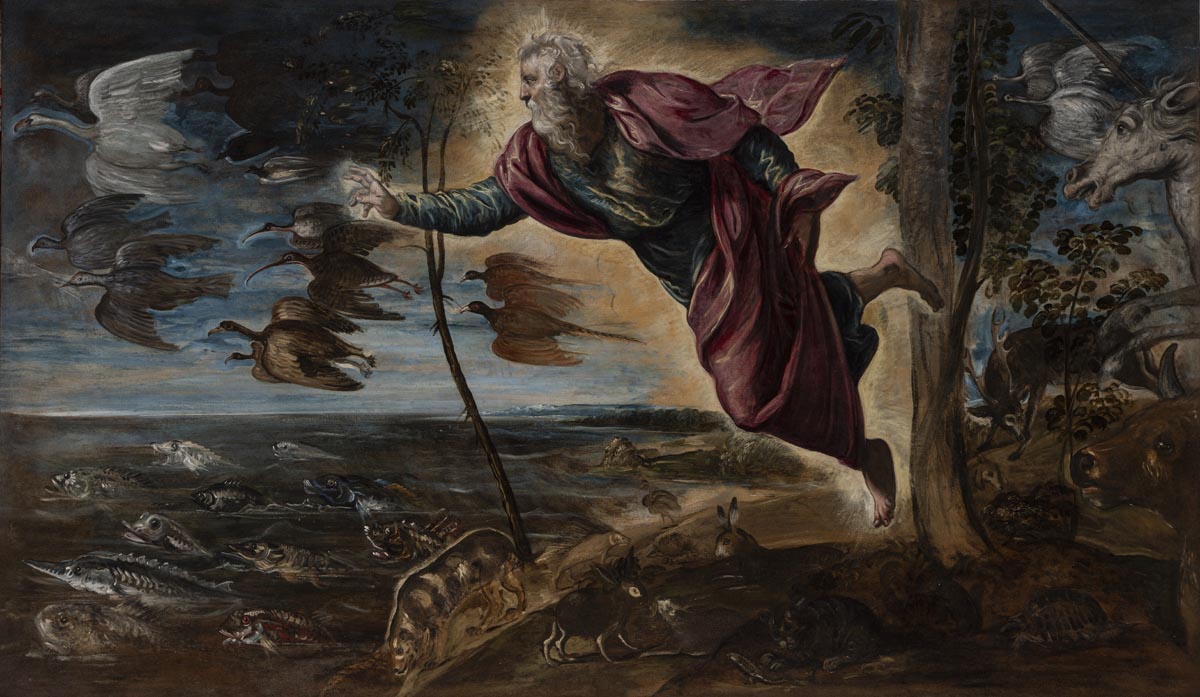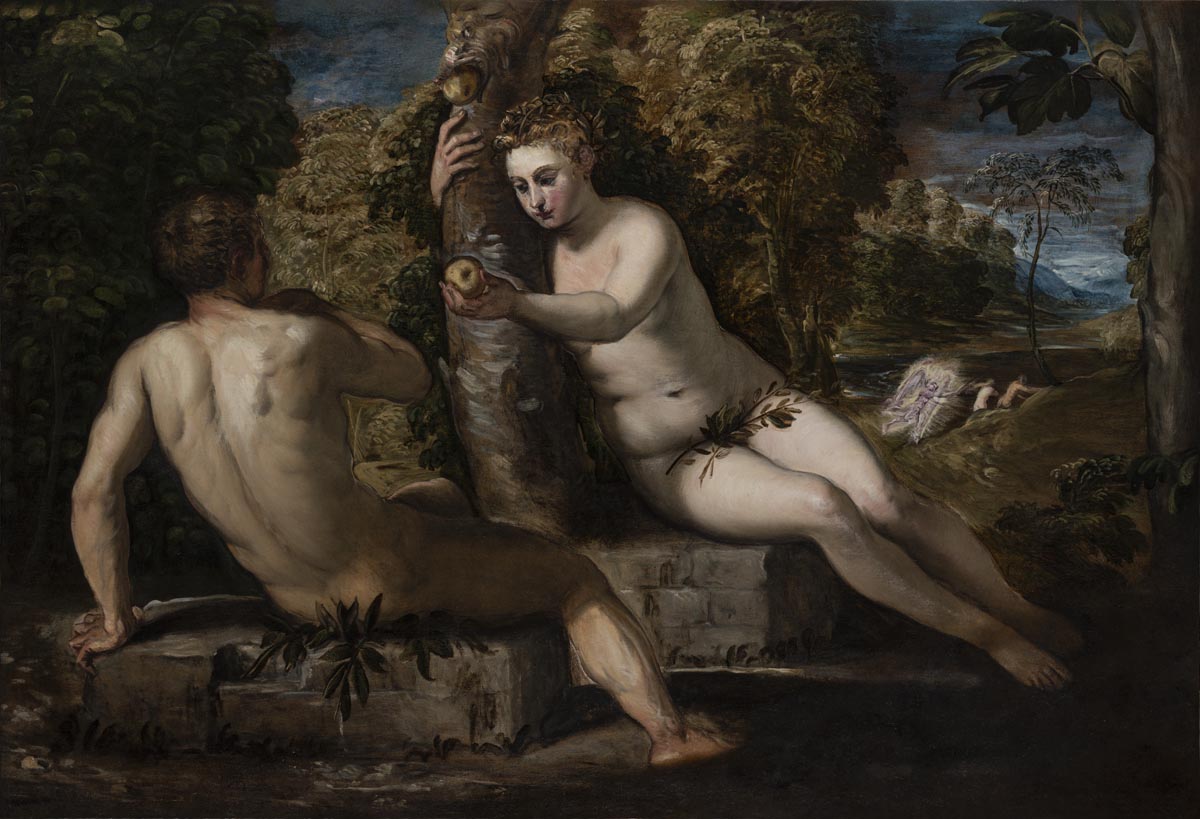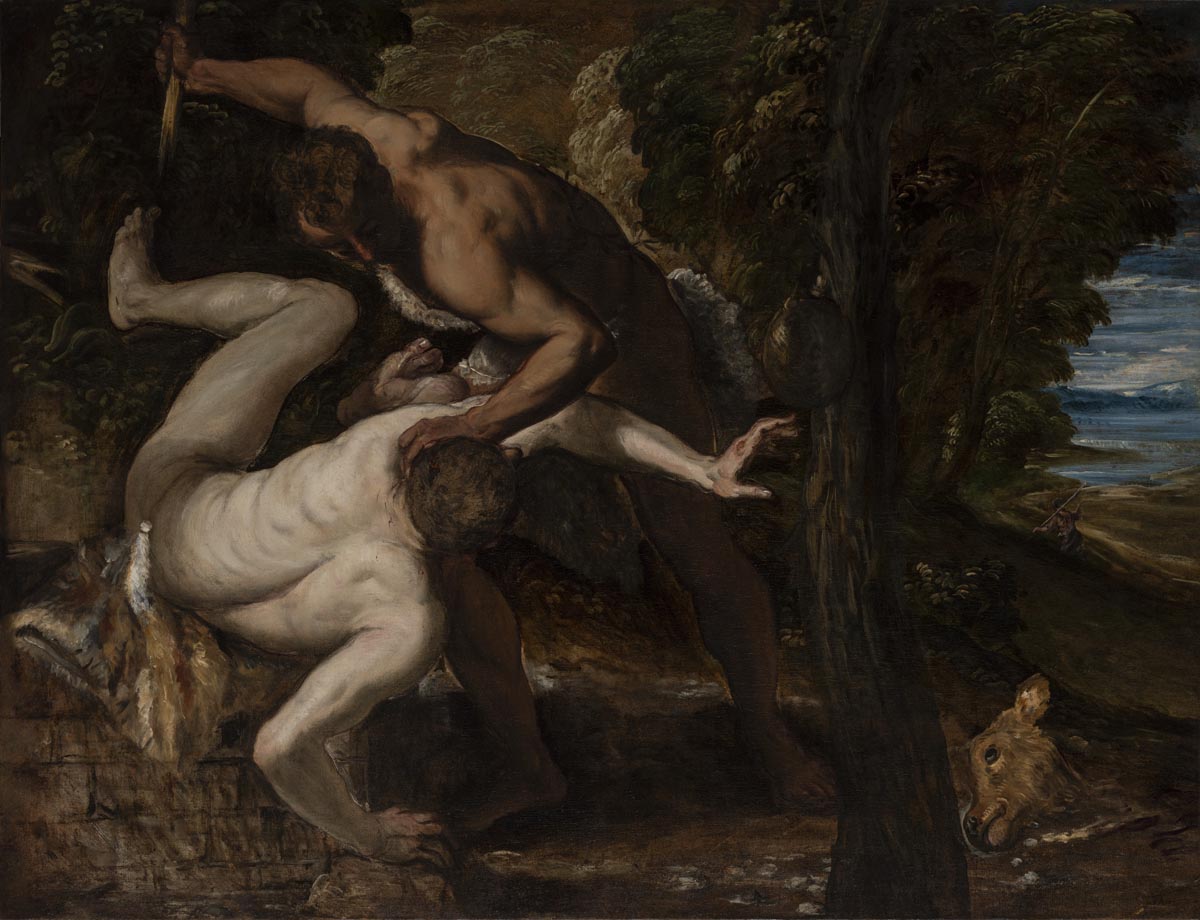- Art
- Exhibitions
- Farm to Table: Food and Identity in the Age of Impressionism
- Tintoretto’s Genesis
- Special Features
- Upcoming Exhibitions
- Past Exhibitions
- Online Exhibitions
- Explore the Collection
- Provenance and Cultural Property
- Conservation
- Meet the Curators
- Digital Resources
- Art Bridges Cohort Program
Introduction
I’m Peter Bell, the museum’s curator of European painting, sculpture and drawings. I will be sharing the introduction for Tintoretto’s Genesis.
In the early 1550s, Jacopo Tintoretto (1518–1594) made a series of paintings depicting scenes from the Judeo-Christian Bible’s Book of Genesis for the Scuola della Trinità, a charitable organization in Venice. Painted in the early years of the artist’s mature career, these canvases display a fusion of Michelangelo’s forceful conception of the figure, Titian’s renowned colorism, and Tintoretto’s own uniquely vigorous brushwork and dynamic compositions. The paintings mark the beginning of Tintoretto’s rise as the powerhouse of Venetian Renaissance painting. Across the next four decades, he would paint thousands of square feet of canvas for the most powerful patrons and prestigious institutions in Venice.
Over the past year, a research and conservation project undertaken by the Gallerie dell’Accademia, Venice, and supported by the Foundation for Italian Art and Culture and the Cincinnati Art Museum, has yielded a new understanding of how Tintoretto made the three best preserved and most compelling of the Trinità paintings, and how the artist and his patrons intended for them to be displayed. It has also breathed new life into the artworks, reviving the complexity of their compositions and vibrancy of their colors.
Tintoretto & the Trinità
I’m Peter Bell, the museum’s curator of European painting, sculpture and drawings. I will be sharing the “Tintoretto & the Trinità” panel in Tintoretto’s Genesis.
The Scuola Santissima della Trinità, a Catholic charitable brotherhood, was founded in 1418 in a monastery complex on the Grand Canal near the tip of the Dosoduro sestiere (neighborhood) of Venice. The organization began a significant decoration campaign for their building in 1547, which included the commission of paintings to Francesco Torbido (1486–1562) and Tintoretto, along with painted and gilded wood paneling. The Scuola relocated several times in the 1600s before disbanding in the late 1700s.
In addition to Tintoretto’s three paintings on view here, two others from the series survive in compromised condition: Admonition of Adam and Eve, now in the Gallerie degli Uffizi, Florence, and Creation of Eve, recently rediscovered in a German private collection. Tintoretto made several paintings of other subjects for the Scuola that are now lost.
The project team’s reinterpretation of archival documents and the paintings’ compositions have led to a new proposal for the original location of the paintings in the main meeting room of the Scuola. Torbido’s four lost paintings, that we know depicted the first acts of creation from the Book of Genesis, would have hung on the north wall; Tintoretto’s paintings would have continued the narrative with the Creation of the Animals on the (east) entry wall, and his four other surviving paintings with scenes of Adam and Eve and Cain and Abel progressing along the south wall.
The Artist at Work
I’m Peter Bell, the museum’s curator of European painting, sculpture and drawings. I will be sharing the “The Artist at Work” panel in Tintoretto’s Genesis.
With advanced imaging technology and deep expertise, the conservation, curatorial and scientific staff at the Gallerie dell’Accademia, Venice, were able to understand and describe the thin layers of different materials with which Tintoretto made each painting, and see through them to varying degrees.
This technical study allows us to look back in time and retrace the artist’s process as he and his workshop constructed and prepared the canvases, transferred preliminary ideas onto them with charcoal and washes,
revised those ideas in drawing and sometimes even after beginning to apply paint, and finally brought the works to life through color and shading.
The Life of a Painting
I’m Peter Bell, the museum’s curator of European painting, sculpture and drawings. I will be sharing the “The Life of a Painting” panel in Tintoretto’s Genesis.
Archival documents and museum records indicate the paintings were relocated at least four times and underwent restoration treatments six or seven times from as early as 1661 to 2011. Many of these interventions’ effects and indicators became apparent as the 2024 conservation treatment progressed.
This information complements findings from archival documents and scientific imaging and analysis, all adding up to a surprisingly full history of these paintings across their 474-year life.
Scuole
I’m Peter Bell, the museum’s curator of European painting, sculpture and drawings. I will be sharing the “Scoule” panel in Tintoretto’s Genesis.
Scuole, literally translated as “schools,” were lay brotherhoods that developed in northern Italy in the late medieval period. In Renaissance Venice, scuole provided important social, religious and charitable structures. Primarily organized by middle-class (male) citizens, the groups provided direct support—like food and dowries—to the city’s poor.
To conduct their charitable works and governance, and to increase their prestige, the scuole built and decorated their meeting rooms and associated churches, providing a significant source of work for Venetian artists in the 15th and 16th centuries.
Tintoretto’s career was shaped by scuole commissions—from his break-out 1548 success with the Miracle of the St. Mark for the Scuola Grande di San Marco, to his comprehensive decoration of the Scuola Grande di San Rocco, a twenty-five year undertaking. Since their creation, these works have been required viewing by visitors to Venice, and were often reproduced in prints, several of which are on view here.
The Creation of the Animals

Jacopo Robusti, called Jacopo Tintoretto (Italian, 1519‒1594), The Creation of the Animals, 1550‒53, oil on canvas, 55 1/8 x 77 3/16 in. (140 x 196 cm), Gallerie dell’Accademia, Venice, cat. 900, courtesy of the Ministry of Culture
Description
I’m Maria Jenkins, the museum’s assistant director of adult & studio programs. I am sharing a description of The Creation of the Animals in Tintoretto’s Genesis.
The Creation of the Animals is an oil on canvas painted between 1550 and 1553. The artist is Jacopo Robusti, also called Jacopo Tintoretto. An Italian, he lived from 1519 to 1594. The painting is in the collection of the Gallerie dell’Accademia in Venice, and the cataloging number is 900. It is in the exhibition courtesy of the Ministry of Culture.
The Creation of the Animals measures 55 and one-eighth by 77 and three-quarter inches or 140 by 196 centimeters. Horizontally oriented, this large painting captures the Christian God at the moment in the Creation story in which he creates the fish, birds, and mammals. God is at the center of this work. Depicted as a white man with white hair and a long beard, he wears a long-sleeved blue gown with a red drapery wrapped around him. He appears to float at the edge of a large body of water; a golden halo surrounds him. His left arm hangs at his side while his right extends out with two fingers raised. To his right, as if behind him, a tree divides God from a white unicorn, cow, deer with horns, and two white cranes in the sky. The unicorn and cow appear to be walking into the painting, only their heads visible along the edge. Under God’s feet are a cat, three rabbits, a turtle, what may be a dog and other not clearly defined animals. In front of God, on the left side of the painting, is a vast expanse of blue sky and murky brown water. Various fish types populate the sea, and several species of birds fly in the sky.
Label
I’m Maria Jenkins, the museum’s assistant director of adult & studio programs. I am sharing the label for The Creation of the Animals in Tintoretto’s Genesis.
The Creation of the Animals is an oil on canvas painted between 1550 and 1553. The artist is Jacopo Robusti, also called Jacopo Tintoretto. An Italian, he lived from 1519 to 1594. The painting is in the collection of the Gallerie dell’Accademia in Venice, and the cataloging number is 900. It is in the exhibition courtesy of the Ministry of Culture.
And God created the great whales, and every living and moving creature, which the waters brought forth, according to their kinds, and every winged fowl according to its kind. And God saw that it was good.
…
And God made the beasts of the earth according to their kinds, and cattle, and everything that creepeth on the earth after its kind. And God saw that it was good.
Genesis 1:21, 25 (Vulgate, Douay-Rheims translation)
Tintoretto was known to have used sculptural models as compositional aids. Here he may have used a mannequin suspended from the ceiling of his studio to help him define the dynamic pose of God. The emphatically horizontal composition accords with the biblical sense of impetus and momentum—the “bringing forth” of all the creatures. God and many of the animals move decisively from right to left across land, sea and sky.
Although Tintoretto devoted most of his creative energy in this painting to the figure of God, the description of different species of fish and waterfowl remind us how closely connected Venetians were to the other inhabitants of the lagoon and the sea.
The Temptation of Adam

Jacopo Robusti, called Jacopo Tintoretto (Italian, 1519‒1594), The Temptation of Adam, 1550‒53, oil on canvas, 59 1/16 x 86 5/8 in. (150 x 220 cm), Gallerie dell’Accademia, Venice, cat. 43, courtesy of the Ministry of Culture
Description
I’m Emily Agricola Holtrop, the museum’s director of learning & interpretation. I am sharing a description of The Temptation of Adam in Tintoretto’s Genesis.
The Temptation of Adam is an oil on canvas painted between 1550 and 1553. The artist is Jacopo Robusti, also called Jacopo Tintoretto. An Italian, he lived from 1519 to 1594. The painting is in the collection of the Gallerie dell’Accademia in Venice, and the cataloging number is 43. It is in the exhibition courtesy of the Ministry of Culture.
The Temptation of Adam is a sizeable horizontally oriented painting measuring 59 and one-sixteenth by 86 and five-eighths inches or 150 by 220 centimeters. Here, the Christian Bible’s first couple, Adam and Eve, sit in a lush garden filled with rich vegetation. Around them leafy trees in green and gold are present. In the foreground and to the left, Adam is nude, sitting on a spray of dark green branches and on what appears to be a flat gray block. His muscled back is to the viewer, and he rests his weight on his extended left hand as if leaning away from Eve. Adam bends his right arm at the elbow, and his fingers touch his chin. He turns his head, complete with short-cropped light brown hair, toward Eve. His wife is in the center of the painting. She is also shown nude, except for a few branches in her lap. She also sits on a series of gray bricks and leans on a tree trunk. She raises her right arm and wraps it around the tree. She extends her left arm toward Adam holding a yellow apple. She also has light brown wavy hair. Above her, on the tree trunk, a snake with an apple in its mouth peaks out from the top of the painting.
In the background, Adam and Eve appear again, this time standing. A winged glowing angel accompanies them. It points away from the garden, and the couple walk in that direction.
Label
I’m Emily Agricola Holtrop, the museum’s director of learning & interpretation. I am sharing the label for The Temptation of Adam in Tintoretto’s Genesis.
The Temptation of Adam is an oil on canvas painted between 1550 and 1553. The artist is Jacopo Robusti, also called Jacopo Tintoretto. An Italian, he lived from 1519 to 1594. The painting is in the collection of the Gallerie dell’Accademia in Venice, and the cataloging number is 43. It is in the exhibition courtesy of the Ministry of Culture.
But of the fruit of the tree which is in the midst of paradise, God hath commanded us that we should not eat; and that we should not touch it, lest perhaps we die.
And the serpent said to the woman: No, you shall not die the death.
For God doth know that in what day soever you shall eat thereof, your eyes shall be opened: and you shall be as Gods, knowing good and evil.
And the woman saw that the tree was good to eat, and fair to the eyes, and delightful to behold: and she took of the fruit thereof, and did eat, and gave to her husband who did eat.
Genesis 3:3-6 (Vulgate, Douay-Rheims translation)
In this unusual and highly successful composition, we first encounter Adam, whom we see entirely from the back as we enter the pictorial space. With her arm wrapped around the tree trunk, and offering the fruit, Eve echoes the serpent above. Adam recoils, so that the two figures, in complementary poses and carefully distinguished flesh tones, pivot around the forbidden tree. (As with the other paintings on view here, Tintoretto uses the vertical tree trunks as a compositional device.)
They sit on masonry pedestals, which stage the figures like sculptures. The pedestals also mimic altars, alluding to the couple’s role in prefiguring Christ and his sacrifice. To the right, we see an angel enveloped in light banishing the couple from Eden.
Cain and Abel

Jacopo Robusti, called Jacopo Tintoretto (Italian, 1519‒1594), Cain and Abel, 1550‒53, oil on canvas, 58 11/16 x 77 3/16 in. (149 x 196 cm), Gallerie dell’Accademia, Venice, cat. 41, courtesy of the Ministry of Culture
Description
I’m Lauren Caskey, the museum’s curatorial fellow for European Art. I am sharing a description of Cain and Abel in Tintoretto’s Genesis.
Cain and Abel is an oil on canvas painted between 1550 and 1553. The artist is Jacopo Robusti, also called Jacopo Tintoretto. An Italian, he lived from 1519 to 1594. The painting is in the collection of the Gallerie dell’Accademia in Venice, and the cataloging number is 41. It is in the exhibition courtesy of the Ministry of Culture.
A large horizontally oriented painting, Cain and Abel measures 58 and eleven-sixteenths by 77 and three-sixteenths or 149 by 196 centimeters. Cain and Abel grapple in the foreground of a wooded landscape. On the left side of the painting, we see the nude form of Abel from the back, his skin is pale, almost white. He is falling backward, his backside on a short raised wall, his left leg, bent at the knee, extends above him, and his foot appears to be touching the dense foliage. His right foot is next to his left thigh. His left arm reaches to the left while his bent right arm braces his fall. Standing and bent over Abel is his brother, Cain. Shown in shadow, Cain looks down on Abel. His left hand grasps his brother at the neck, his right arm extends to the right, and he holds a pointed stake. He appears to have an animal fur wrapped around his torso and waist.
To the right of the fighting forms is a thin tree, a canteen hanging from the branches. In the lower-right corner is the head of a deer. Cain appears again as a small figure wandering in the background, where the landscape continues, leading back to a blue expanse of water and sky.
Label
I’m Lauren Caskey, the museum’s curatorial fellow for European Art. I am sharing the label for Cain and Abel in Tintoretto’s Genesis.
Cain and Abel is an oil on canvas painted between 1550 and 1553. The artist is Jacopo Robusti, also called Jacopo Tintoretto. An Italian, he lived from 1519 to 1594. The painting is in the collection of the Gallerie dell’Accademia in Venice, and the cataloging number is 41. It is in the exhibition courtesy of the Ministry of Culture.
And it came to pass after many days, that Cain offered, of the fruits of the earth, gifts to the Lord.
Abel also offered of the firstlings of his flock, and of their fat: and the Lord had respect to Abel, and to his offerings.
But to Cain and his offerings he had no respect: and Cain was exceedingly angry, and his countenance fell.
…
And Cain said to Abel his brother: Let us go forth abroad. And when they were in the field, Cain rose up against his brother Abel, and slew him.
Genesis 4:3-5, 8 (Vulgate, Douay-Rheims translation)
Tintoretto conceives this dark parable in gruesome and humanizing detail, as Abel, seated, topples backward from an unexpected blow that has opened a wound on his head and spattered blood on his back. Cain has drawn back to strike again. Tintoretto adjusted the complex tangle of bodies several times while working on the painting to achieve maximum drama and action. A lush landscape, which in Adam and Eve evokes the Garden of Eden, here instead becomes a thicket of sin—jealousy and fratricide.
Probably because of damage, the painting was cut down on the right side. The figure of God once hovered over the small figure of Cain, fleeing in the background, protecting him as “a wanderer and fugitive on the earth” (Genesis 4:14), to whom God will always offer a chance of redemption and salvation.






